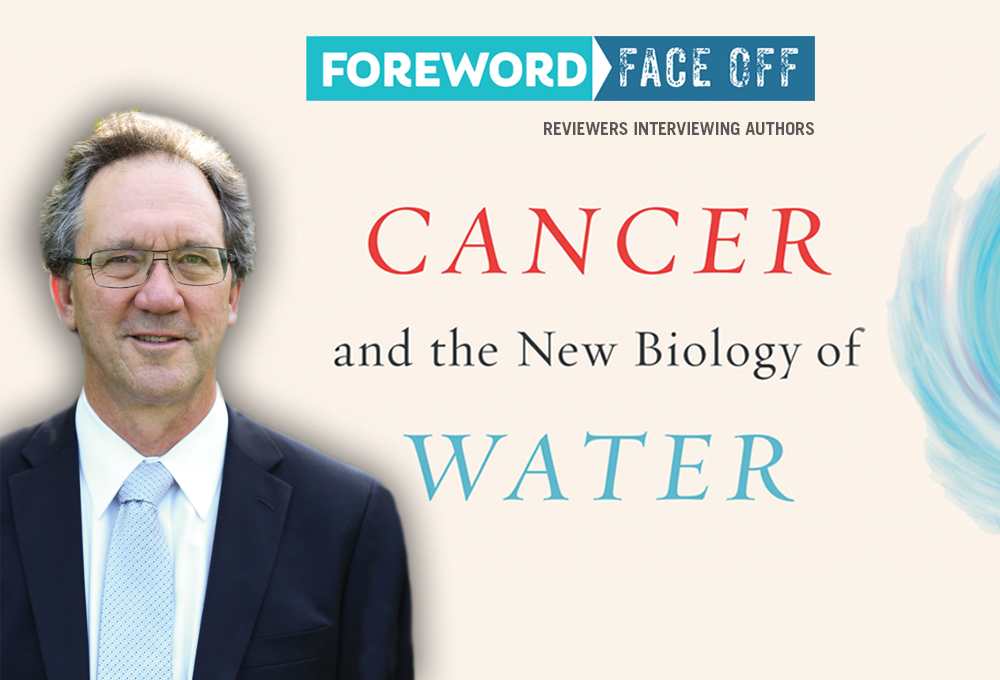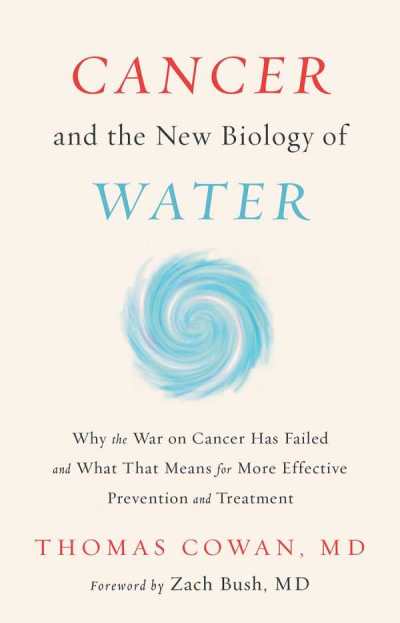Reviewer Matt Sutherland Interviews Thomas Cowan, Author of Cancer and the New Biology of Water

Since his bout with throat cancer three-plus years ago, Editor-in-Chief Matt Sutherland has been hot to discover new books on cancer prevention. Well aware that cancer loves nothing more than to aggressively reappear, Matt reviews the most intriguing of the books in Foreword Reviews magazine and, at home, experiments with low-carb, high-fat dieting (ketogenic), supplements, EMF avoidance, high-intensity workouts, meditation, earthing, and other health practices that the American Medical Association and most oncologists dismiss as “alternative,” and certainly not effective cancer preventatives. No surprise.
In fact, this nation’s multibillion-dollar cancer industry is only in the business of treating cancer, not preventing it. And even the industry’s complete reliance on chemotherapy and radiation means that many other promising, less toxic forms of cancer treatment are overlooked.

So, where do cancer sufferers turn if they’d like to hear more about alternatives or complements to chemo/radiation? And what’s a good source for respectable information on cancer prevention?
Chelsea Green, take a bow. The publisher of scores of books on integrative health and wellness, including alternative approaches to cancer prevention and treatment, Chelsea Green is the go-to source for readers seeking reputable, well-researched, important new books from outside of mainstream health circles.
Their latest is Cancer and the New Biology of Water: Why the War on Cancer Has Failed and What That Means for More Effective Prevention and Treatment. As he has with numerous other CG titles, Matt reviewed the book (September/October 2019 issue) and proceeded to chase down author Thomas Cowan, MD, for an interview.
Water, we thought we knew you. Matt, take it from here.
First of all, before we talk about some of the science behind your ideas, I want to say that I was fascinated by your chapter on René Quinton and his realization that “our blood reflects the mineral composition of the oceans.” This connection between seawater and blood was the aha moment that fully opened my eyes to the genius of your book. Please help us understand how miraculous seawater is as it relates to life, all life, on earth, as well as the health of humans?
The mineral composition of the fluid part of the blood (i.e., the serum) is identical to the mineral composition of ocean water. That is essentially the rationale for Celtic sea salt as it is one of the few that simply evaporates off seawater to make salt. The rest of the sea salts tend to be pure sodium chloride. The result of eating processed salt is similar to processed sugar—the longer you eat it the higher you get in sodium, the lower in all the other essential minerals and then sickness ensues. The genius of Quinton was first to document that our blood is seawater, but “structured” or vortexed sea water. Then he figured out how to collect vortexed sea water, purify it, and keep it stable. This allows the user of the water to rebalance their mineral state, which is one of the fundamental keys to good health.
In the book, you clarify the misconception that water has only three states—liquid, ice, and steam—when, in fact, there’s a fourth: gel. You more commonly refer to this fourth state as “structured” water, and that this form of water/gel is what’s inside our cells. Strikingly, you credit this substance as being a carrier of the body’s life force, and the single most important factor for our well-being. In your words, “Health is the state of perfect intracellular gels. Disease is when this gel state deteriorates.” Please tell us how you arrived at this conclusion?
I arrived at this conclusion mostly by looking at physiology and what the most important and successful cancer programs are trying to accomplish. Our most important biological functions are to establish voltage or a charge in our cells, which is accomplished by the intracellular gel. This allows the cells to assume their proper spatial orientation which is key to function and lost in cancer. The intracellular gel also controls the expression of our DNA, another fundamental biological function. We are far too focused on the gene and not how it gets expressed. The expression is a result of its being acted on by the gel.
And, as I said, really all of the successful cancer programs of the last 100 years were working with the gels whether they knew it or not.
So the million dollar questions are: What causes poor intracellular gel and what can we do to maintain or improve the health of our intracellular gel?
Intracellular gels are formed from two directions: The first is the quality of the water itself. The second is the forces that act on the water. Gerald H. Pollack proves this with experiments in which he suspends a horizontal hydrophilic tube in water. If you put this beaker of water in a lead box the water doesn’t flow through the tube. The flow is a direct consequence of the ability of the water to form gels. If you have deuterium-rich water, you get no flow; if you have water with toxins in it you get less flow. If you shine the sun on the water, the flow increases; if you put the beaker of water directly on the earth, it increases flow; if you put your hands or your dog next to the water, this increases flow. If you shine red incandescent light on the water, the flow increases. This can only be because of increased energy available to form gels.
On the other hand, if you put your cell phone, or any other wireless device next to the water, the flow lessens. Any non-native EMF (Electromagnetic Field) makes the water more chaotic, deteriorates the gels, and causes widespread disease. It’s due to a direct effect on the ability of EMFs to inhibit the ability of water to form healthy gels.
Please talk more about EMFs and why you’re convinced they’re so harmful? What other factors do you think have caused the spike in cancer over the past 100 years?
10,000+ research papers have pointed to the harmful effects of EMF. When you look at cancer incidence over the past 100 years, there was a spike with the introduction of AM radio, then another spike with FM radio, then television, then electronic devices, then 3G and 4G—and the coming spike with 5G will make the previous spikes look like child’s play.
There are lots of other factors. My four horsemen of the apocalypse are EMFs, glyphosate/modern agriculture, vaccines, and school.
You call structured gel the consciousness of our cells, meaning the gel determines the countless ways DNA expresses itself in our bodies through activity between genes and proteins. Complicated stuff, but can you talk about why this insight is so important to the future of health and medicine?
Gene expression is a huge topic these days, everyone is testing their genes, examining their genes, and trying to modify their genes. They forget that even the worst genetic diseases like cystic fibrosis have a variable expression. One person will live 10 years, the next will live 40 years. Genes determine nothing, the expression of the genes determines everything. The expression, as stated by the director of the Human Genome Project, is a result of the “interstitium,” by which he means the water environment that surrounds and, in essence, controls this expression.
As a throat cancer survivor (so far) and ketogenic dieter for the three years following my cancer (chemo and radiation) treatment, I was a bit disheartened to read about some of the new research you cite showing that the body doesn’t ever let blood glucose levels drop to cancer-starving levels. So those of us who strictly avoid carbs (sugar) hoping to keep our glucose levels low need to rethink our approach. It’s apparent in the book that you’re still a big fan of ketogenic dieting, so will you talk about why you believe high-fat, very low-carb diets are effective?
High-fat, low-carb diets, in my opinion work because when one metabolizes fat exclusively, it lowers the deuterium levels in the cell, which helps the cancer process. When one uses carbs for fuel, deuterium levels in cells go up. Deuterium levels control the rapidity of cell division and are integral in determining the structure of the intracellular gels. This is because fats are a complex molecule that can’t tolerate the inclusion of deuterium in their composition, whereas carbs are simpler and can use deuterium. Therefore a high-fat, low-carb or ketogenic-type diet is essentially like drinking deuterium depleted water which has been shown to benefit cancer patients.
In your chapter “Energetic Life Forces,” you further explain that cancer is a “cytoplasmic, rather than a nuclear disease,” and that healthy, structured water in our body is infused with “life force.” Can you give us a workingman’s understanding of this stuff (life force)? Additionally, and I know this is a difficult, if not impossible question to answer—you admit as much in the book—but are we getting closer to discovering a way to source this life-force power directly?
If you look at the composition of an atom, which we are told are the basic building blocks of all the stuff on earth, there is a fundamental paradox. 99.999+ percent of the atom is space, i.e., nothing. How is it that a structure made of 99.999+ percent nothing seems solid. Apparently, no one knows. The modern physicists say the space is “energy,” they also say this stuff can exist as a particle or a wave, where nothing is solid. And the thing that determines whether this stuff acts as a particle or wave is whether it is being observed. The problem, or at least one problem in medicine and biology, is that medicine still believes in the materialistic Newtonian worldview of the primacy of stuff over energy, something that physicists call a fiction or delusion of confused minds.
Yes, people including me are busy using energy devices [to directly enhance the body’s life force], which, while not perfect, hold great promise for the future of medicine.
What’s the deal with deuterium in water, and why should we find a way to avoid it?
When deuterium accumulates in the cells it overstimulates cell division, interferes with energy generation and energy pathways, and deteriorates the structure of the cell. These are just some of the ways it causes disease. Every common water has about one drop of naturally occuring D2O instead of H2O per liter. Because over 99 percent of the molecules in our bodies are water, this adds up to a lot. As we age, it accumulates and causes problems.
Over the years, you’ve done game-changing work in the fields of vaccines, autoimmunity, childhood illness, the human heart, and cancer among other topics. Can you divulge what you’re currently researching as the basis for your next book?
Well, I was asked to write a book about raising healthy children in a toxic world, so I wrote it. Whether it will ever be published remains to be seen. In some ways it was my “thank you” to Ivan Illich, my favorite writer. I spent a lot of time in the book on what Illich calls radical monopolies, which are killing us all. Two of the most pernicious are EMFs and mandatory schooling. I hope I get to make my case for this soon.
Matt Sutherland
